G-ADUV. Short S.23 'C' Class Empire Flying Boat. c/n S.813. |
This aircraft was the sixth Empire boat to be completed and flown by Short Bros at Rochester, Kent The order was placed by Imperial Airways, London - January 24, 1935 The official written order shows the cost of the aircraft at UKP 37,800 - February 19, 1935 Converted to present day values this would be approximately UKP 3,417,876 Built as an S-23 Empire Class Mk.III flying boat having 920 h.p. Bristol Pegasus Xc poppet-valve radial engines It was the 2nd 'long-range' S.23 boat and was often referred to as a 'Atlantic' boat It was fitted with the 'Type M1B' fuel system - consisting of two fuel tanks of 326 and 2 tanks of 179 gallons mounted within the wings plus 2 hull-mounted tanks of 280 gallons each - for a total fuel capacity of 2,330 gallons This provided a flight duration of approximately 17 hours 40 minutes Its range in still air was 2,754 nm (5,110 km) or against a 35 kt headwind the range was 1,911 nm (3,545 km) Entered onto the British Aircraft Register as G-ADUV (CofR 6376) - October 07, 1935 Registered to Imperial Airways Ltd, Victoria Station, London It was allocated a 'Fleet Number' (No. 5) which was used in all operational records to identify the aircraft This aircraft should have been allocated 'Fleet No. 6' as 'G-ADUW - Castor' was launched 27 days before this aircraft, but it was never corrected Launched on the Medway River at Rochester without cabin fittings - January 11, 1937 The aircraft was named 'Cambria' First flown at Rochester by the Short Brothers' Chief Test Pilot, John Lankester Parker - January 11, 1937 Certificate of Airworthiness (CofA No. 5750) issued - January 15, 1937 Delivered to Imperial Airways, London - January 21, 1937 It was immediately pressed into service operating Hythe - Alexandria - January 21, 1937 It carried engineers, a spare engine and other associated equipment in order that repairs could be carried out on G-AHDL 'Canopus' that had suffered an engine fire near Crete It operated a special long-distance non-stop flight Hythe - Hythe - February 22, 1937 Route: Hythe - South London (08:30) - Colchester (09:05) - Great Yarmouth (09:35) - Grimsby (10:05) - South Shields (10:30) - Berwick (11:00) - Edinburgh (12:05) - Glasgow (12:45) - Belfast (13:30) - Kingsdown / Dublin (14:35) - St. David's Head, Pembrokeshire (15:05) - Worm's Head, Swansea (15:35) - Taunton (16:05) - Bournemouth (16:35) - Hythe (16:47) The aircraft was under the command of Captains G. J. Powell and E. N. Gurney 'Cambria' operated a special flight Hythe - Foynes (Ireland) - February 25, 1937 From Foynes it then made several short flights to test this location's suitability as the new 'Atlantic Airport' on the mouth of the Shannon River Wireless, meteorological and general 'ground' organisation and handling was tested These 'technical' tests were intended to be a preliminary run for the 'experimental' flights that would be carried out later between Ireland and Newfoundland 'Cambria' carried six crew under the command of Capt. G. J. Powell; acting F/O Capt. E. M. Gurney; 4 passengers It departed Hythe on a special survey flight to South Africa (Durban) - April 26, 1937 It arrived South Africa (Durban) - May 29, 1937 Route flown: Hythe - Marseilles - Alexandria - Cairo - Luxor - Wadi Halfa - Kareima - Khartoum - Kosti - Malakal - Laropi - Butiaba (Lake Albert) - Port Bell - Kisumu (Kenya) - Mombasa - Dar-Es-Salaam - Lindi - Mozambique - Quelimane - Beira - Durban Radio equipment that was carried on this flight was installed at the various coastal towns as the flight progressed 'Cambria' returned to Hythe after making the non-stop flight from Alexandria - June 04, 1937 Non-stop distance: 2,300 miles; flight time: 15 hours 35 minutes 'Cambria' operated a special flight Hythe - Lisbon to survey the first leg of the proposed route to Horta (The Azores) - July 06 - 11, 1937 It operated its first experimental flight to New York (Port Washington) as 'Experimental Flight 2' - July 1937 Departed Hythe (14:58) on the first leg to Foynes (Ireland) - July 27, 1937 Crew: Capt. G. J. Powell; F/O C. F. Elder; R/Os P. A. Woods; J. M. Lewis Departed Foynes (18:00) on the flight to New York - July 29, 1937 Flight time Foynes - Botwood: 17 hours 35 minutes It arrived at New York (Port Washington - 15:55 GMT) - August 02, 1937 Route: Hythe - Foynes - Botwood - Montreal - New York It departed New York (Port Washington - 15:14 GMT) on the return flight to Hythe - August 06, 1937 It arrived at Hythe (16:01 GMT) on completion of this experimental flight - August 09, 1937 Route: New York - Montreal - Botwood - Foynes - Hythe Flight time Botwood - Foynes: 11 hours 55 minutes It operated its second experimental flight Foynes - New York (Port Washington) - August 26, 1937 Crew: Capt. G. J. Powell; F/O C. F. Elder; R/Os P. A. Woods; H. Dangerfield It was damaged whilst alighting at Toronto when it struck an unknown submerged object This happened during the special 'Goodwill Tour of Canada' during this 2nd trip Engineers and replacement parts were were shipped to New York then transported to Toronto to repair the damage It returned New York (Port Washington) - Foynes - September 28, 1937 Flight time: 10 hours 38 minutes Following the second successful experimental flight to New York 'Cambria' was fitted with 'in-flight refuelling' equipment and carried out a comprehensive program of 'in-flight' refuelling tests in conjunction with the Armstrong Whitworth AW.23 aircraft (K3585) Fuel was first successfully transferred between the two aircraft - January 20, 1938 'Cambria' was converted to full 'Mk I' Empire Flying Boat configuration at the Folland Aircraft Factory at Hamble in preparation for its commencement of commercial operations It officially entered commercial service operating service DS93 - May 18, 1938 Route: Southampton - Kisumu (Kenya) Due to fuel starvation 'Cambria' was force landed at Kroosi Bay (Mozambique) - March 08, 1939 It was then towed some 26 miles to Mozambique Island for repairs Imperial Airways and the original British Airways were merged to form British Overseas Airways Corporation - April 01, 1940 'Cambria' arrived at Alexandria having operated Service SW246 from Sydney - June 10, 1940 Following Italy's entry into World War II, air routes across the Mediterranean Sea were closed - June 10, 1940 'Cambria' was ferried Alexandria - Durban (South Africa) - June 19 - 23, 1940 It was then based at Durban for the remainder of its operational life It operated 6 round trips Cairo - Suda Bay (Crete) - April 24 - May 01, 1941 These flights were to rescue and evacuate troops from the area due to the advancing German army Operated its last cammercial service Cairo - Durban as Flight SE645X - December 26, 1946 It departed Durban on its final flight to Poole (England) - January 11, 1947 It was carrying BOAC staff and equipment On its arrival back at Poole, it was the first time that this aircraft had been in the United Kingdom since May 12, 1940 Ferried Poole - Hythe - January 16, 1947 All useful equipment was then removed from the aircraft at Hythe 'Cambria' was towed to Marchwood on Southampton Water - ? 1947 It was broken up at Marchwood by R. J. Coley and Son, Ltd Cancelled from the British Aircraft Register - January 23, 1947 'Cambria' had flown a total of 13,892 hours |
 |
G-ADUV. Imperial Airways London - 'Cambria' in the original livery at Hythe, circa 1937. (R. N. Smith Collection Copyright Image 2545-933.) |
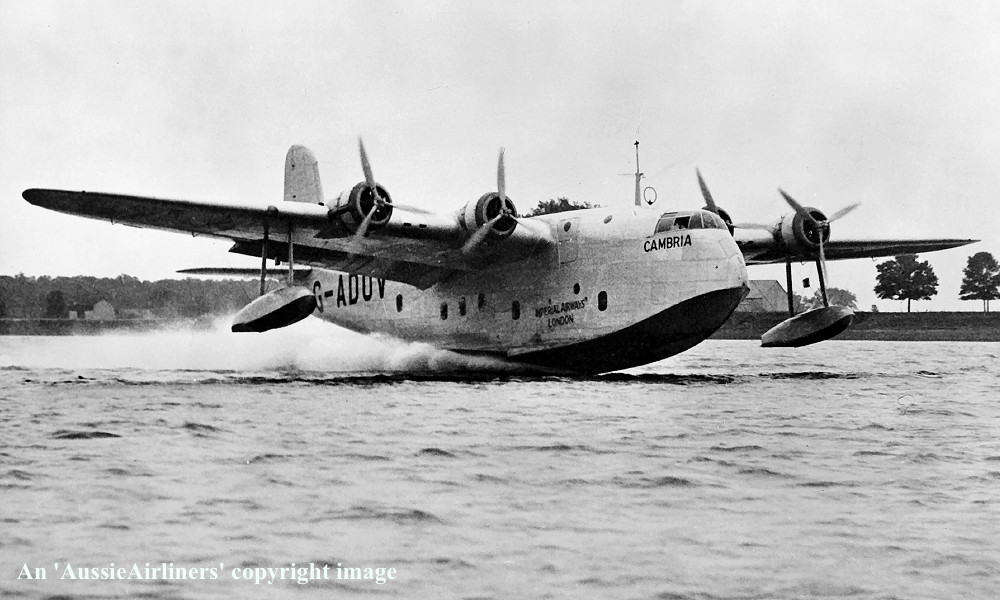 |
G-ADUV. Imperial Airways London - 'Cambria' in the original livery at Boucherville, Montreal, July 1937. (R. N. Smith Collection Copyright Image 2545-264.) |
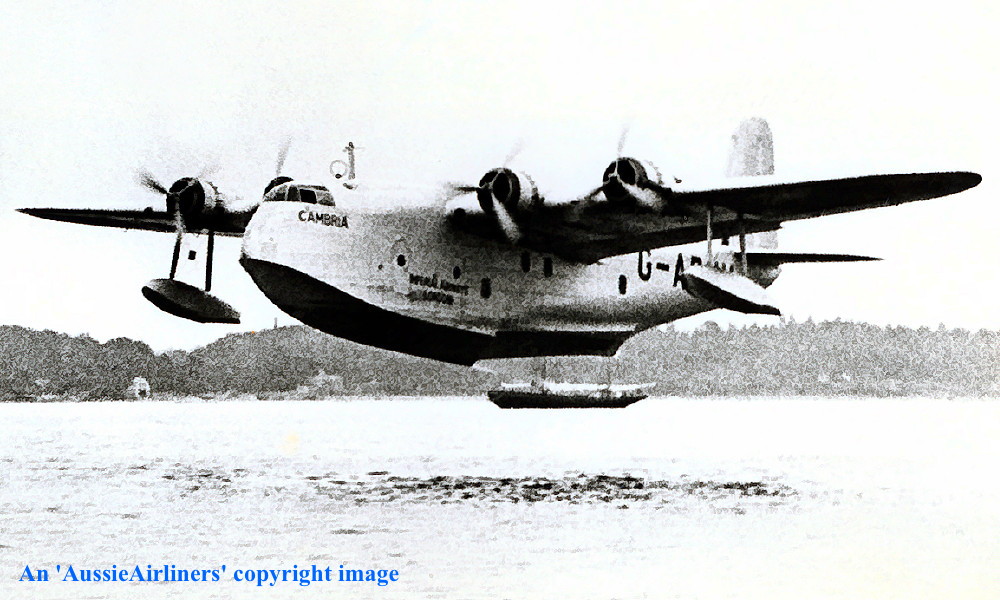 |
G-ADUV. Imperial Airways London - 'Cambria' in the original livery at an unknown location, date unknown. (R. N. Smith Collection Copyright Image 2545-263.) |
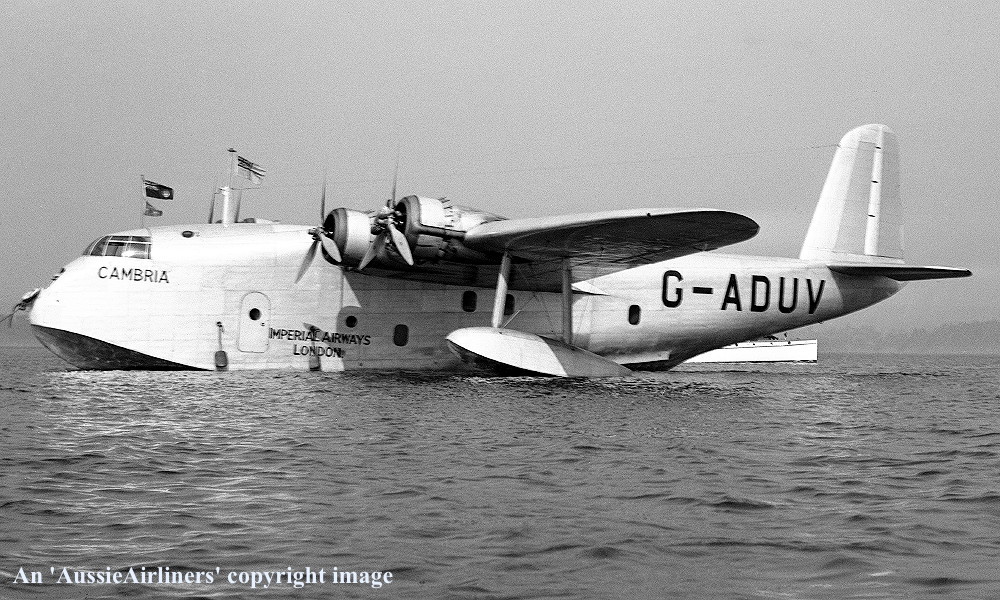 |
G-ADUV. Imperial Airways London - 'Cambria' in the original livery at an unknown location, date unknown. (A. J. Jackson Collection Copyright Image 2545-810.) |
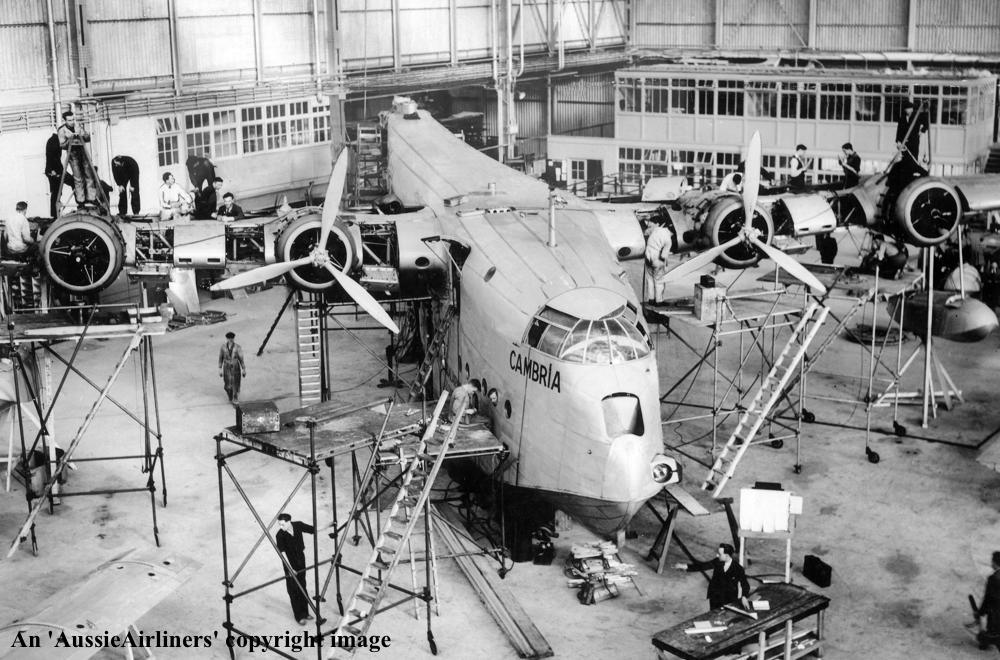 |
G-ADUV. Imperial Airways London - 'Cambria' in the standard livery at Hamble, March 23, 1938. The aircraft was undergoing conversion to the standard Empire layout. (P. Sheehan Collection Copyright Image 2545-895.) |
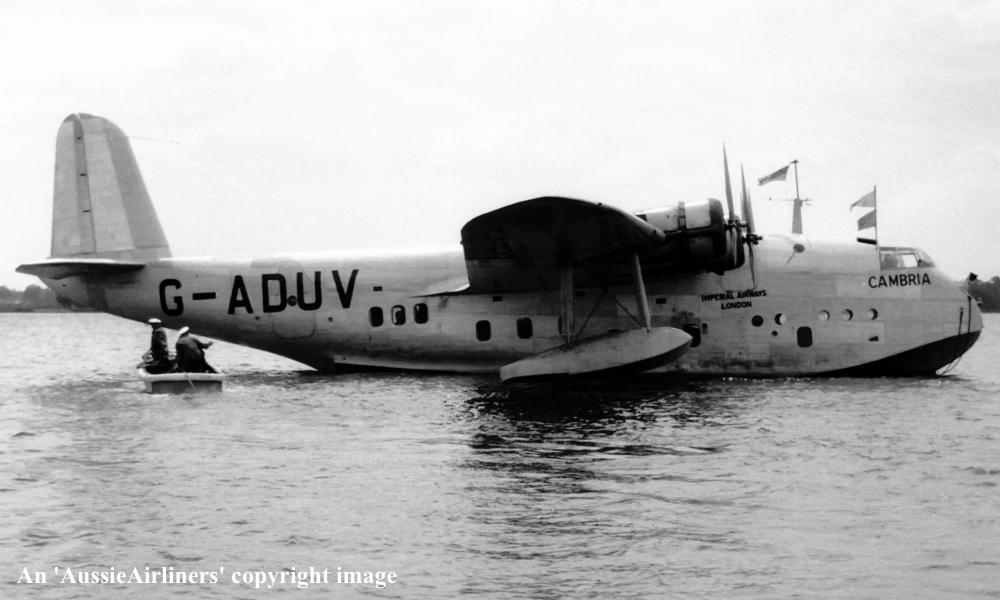 |
G-ADUV. Imperial Airways London - 'Cambria' in the standard livery on The Medway, Rochester, date unknown. (R. N. Smith Collection Copyright Image 2545-896.) |